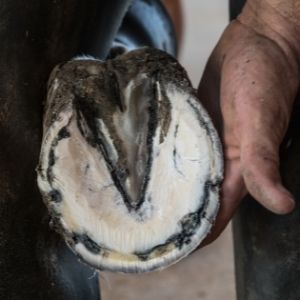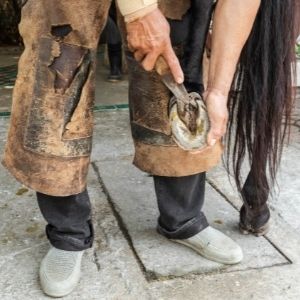Basic horse hoof care
There are quite a few problems that can happen with a horse’s hooves if not properly cared for. So, in this article, we will talk about the problems that can arise, along with proper hoof care for your horse.
How to keep your horse’s hooves healthy
Knowing your horse’s hooves
You need to know the areas that the hooves should be trimmed down, the way they are supposed to look, and the best way to go about trimming them.

The parts of the hoof
Your horse’s hooves consist of:
- The outside hoof lines.
- The area surrounding the horse’s hoof outside of it.
- A band that will connect the pastern and the hoof
- The entire bottom part of a horse’s hoof is called the sole. This is located in the outer wall around the hoof.
- An area that is most likely to have problems is that white line that is directly inside of the outer hoof line.
- Start near the heel, then end at the point in the hoof’s center, this is called the “frog”.
How to trim your horse’s hooves
Once you know the parts of your horse’s hoof and you have decided what part needs to be taken care of, then you can start. Make sure you have everything you need gathered together and beside you.
If this is your first time and you don’t know how much you should trim less instead of more to make sure that you do cause injury to your horse.
You will need to judge for yourself how long or short the wall of the hoof is and look for any area that seems cracked.
Do the horse’s front hooves require trimming? Look at the outer wall of the hoof, is it crooked or uneven?
Correct positioning for you and your horse

Making sure that you are, and your horse is comfortable for this trimming process will be better for both of you and help things go more smoothly. It will also give you better control, help you to get the hooves as even as possible, and to shape the hoof really well.
You will need to hold the horse’s front leg, lift it back and up, in the direction of your horse’s chest then allow the hoof itself to relax on your leg or thigh to trim.
The rear leg needs to be lifted straight up while you put your leg forward in front. You will need to reach down and bend over to trim the hoof.
Make sure that when you are lifting up your horse’s leg that it is at a natural bend at the joints.
Do NOT try to force your horse to bend its leg. When the horse does not want to cooperate, then try again later or another day. If the horse still won’t cooperate you may need to call in someone experienced to help you that first few times.
Time to trim
To trim your horse’s hooves, you need to use a tool that looks like a big nail clipper. This is called “nippers”. They are used for trimming length for the outer wall for the hoof. This is a great way to roughly shape the hoof before doing a fine trim on the rest of the areas.
Position the nippers on all the long places on the outer wall of the hoof. Squeeze and clamp down to make the cut. Make sure to go slow.
On the front hooves, trim at “45-degree angles” so you can avoid sharpness.
Use the rasp
After trimming your horse’s hooves, they will probably be rough and uneven. Your rasp is the tool that looks like a file. This is used for evening out the hooves. Drag it across the hooves to get rid of any rough spots left behind from the nippers and to smooth the hooves out. Use at a very shallow angle as not to hurt your horse.
Until you learn control over the rasp, make short strokes with it to be able to keep the hoof flat.
Trimming the sole
Once the outside wall has been leveled then trim down the sole until you have it below the horse’s outer wall of the hoof. This keeps pressure off of the tender sole inside.
If the horse’s sole tissue feels dead and flaky then it’s okay to trim it but if it feels like elastic, do not trim it.
Remember to keep the outer hoof wall longer than what the sole is.
Final check
Once you are done with each hoof make sure to do another check to ensure all the problem areas are cleaned and trimmed how they should be. Make sure the hoof is level and even. The outer wall of the hoof needs to be flat on the ground.
When to trim
Horse hoof care in winter
Your horse’s hooves will normally grow a lot slower during the winter months. During the winter it should be alright to trim only every 6 to 12 weeks. I time my horse’s hooves every 8 weeks in the winter.
During the wintertime, you should take extra care of your horse if it’s an outside animal or goes out into the snow. If the snow balls up and gets under the sole it can cause an imbalance and severe bruising.
If your horse usually goes without shoes then leave them off. It’s less likely for your horse to slip if there are no shoes on. But, if your horse’s feet bruises easily then keep his shoes on. You can have small cogs and snow pads put under his shoes and nails at the heel. You also will want to use a hoof moisturizer because the winter wind can dry out his hooves.
Horse hoof care in summer
During the summer months, trim your horse’s hooves every 6 weeks at the longest interval. But, my suggestion would be, for the best care, to trim as often as you see it is needed.
Routine horse hoof care
Balanced hoof
A hoof that is balanced will let your horse move much better and it will lessen the strain and the stress on his tendons, bones, and ligaments. There are characteristics of what the idea foot is like. These include: “easy break-over”, “straight hoof-pastern angle”, “medial-lateral balance”, and “adequate heel support”.
Easy break over
The horse’s toe isn’t very long, it’s rolled, squared, or rounded which allows easy movement with every step he takes. if it has too much break-over then this can end up causing problems with his health.
Straight hoof-pastern angle
From the leg where the fur starts, down through the wall of the hoof there is a straight line. This lets the bones align in the proper way from the coffin bone to the pastern. A “medial-lateral balance” is when the foot lands even from one side to the other when your horse is walking.
Adequate heel support
The horseshoe goes back to the hoof wall’s end and helps to support the entire back of the leg. Under the line that is drawn right down the center of the horse’s cannon bone is where the edge of the shoe should be.
Hoof problems that may arise
Thrush
This is a black discharge that is extremely nasty-smelling and usually found around the “frog” area. It comes from soiled, wet conditions. This gets into the tender tissue, it can and will contribute to lameness. To treat this, you need to keep the horse’s barn/stalls dry and clean.
Solar Abscess
This is a severe infection that is found in the hoof’s sole. It leads to severe or acute lameness. The cause of it is bruising, trauma, and can be caused by an object in the hoof. The treatment for this includes soaking the hoof in Epsom salt and warm water, keeping the horse’s hoof dry and clean, and keeping it bandaged up.
Hot nail or street nail
This is exactly what it sounds like, a nail that has been driven into the wall of the horse’s hoof. This will typically cause lameness. To treat this, you will need to flush out the nail hole with an antiseptic then packing the hole and bandaging the foot is what will need to be done. A tetanus shot will need to be given. Make sure to call your vet in on this, it is serious.
Laminitis
This is an inflammation of the laminar, which is a thin layer of bone. It’s a rotation of the coffin bone, it rotates in a downward direction in the horse’s hoof capsule. There are many things that can cause this, but the treatment involves trimming and maintaining toes, also the sole and frog support.
Navicular
This syndrome has disease processes that involve the “navicular bone”, ligamentous soft tissue, and bursa. It will make your horse land toes first because of so much pain being in the heel. The way to treat this is by maintaining short toes, shoeing, pads, break-over, and elevation of the heels.
Conclusion
The best solution for hoof problems is prevention. I suggest doing the following things to help prevent hoof problems.
- Maintain hoof balance
- Alternate between shoes and bare feet for different types of weather.
- Trim hooves regularly.
- Maintain nutrition.
If the disease process occurs then make sure to call a vet.
